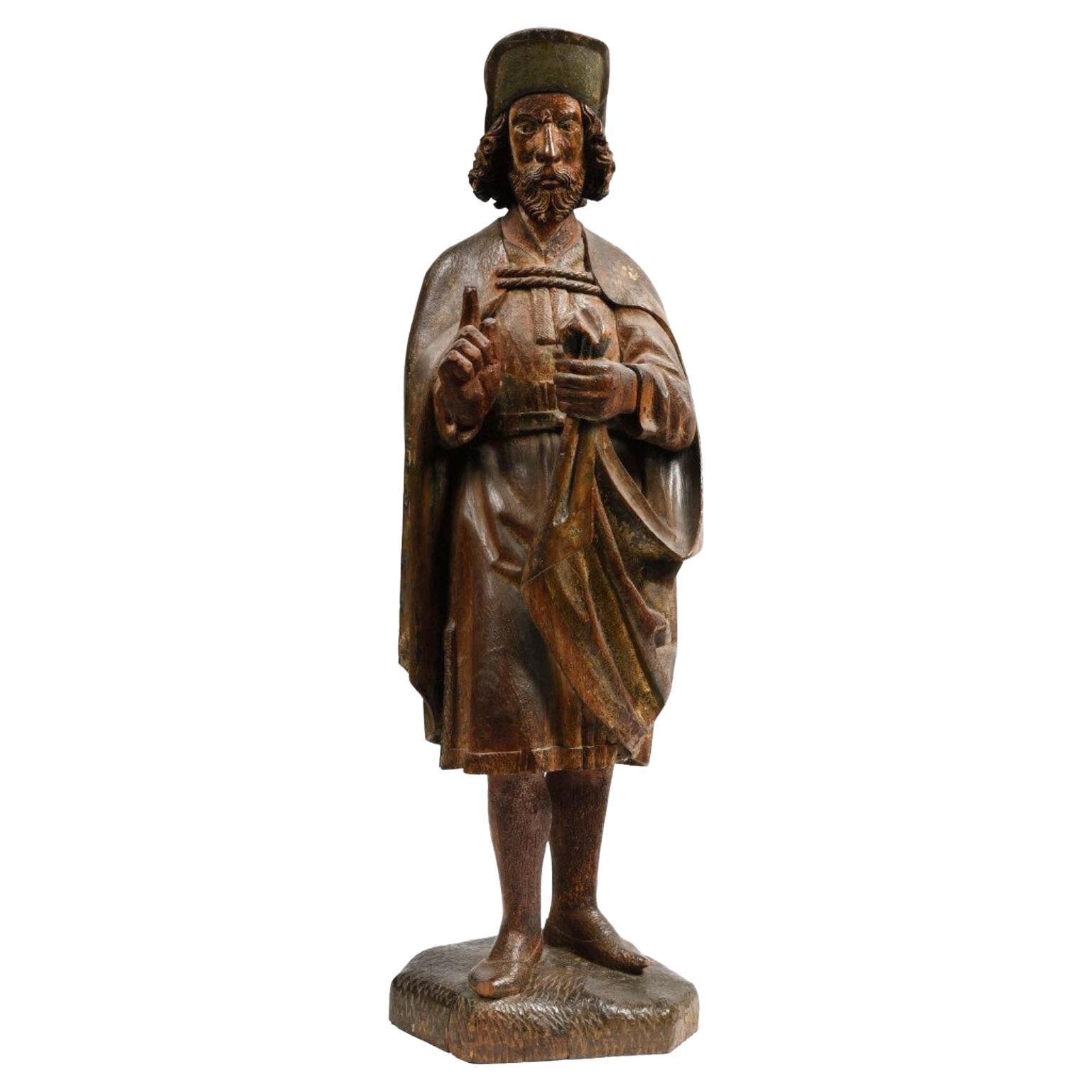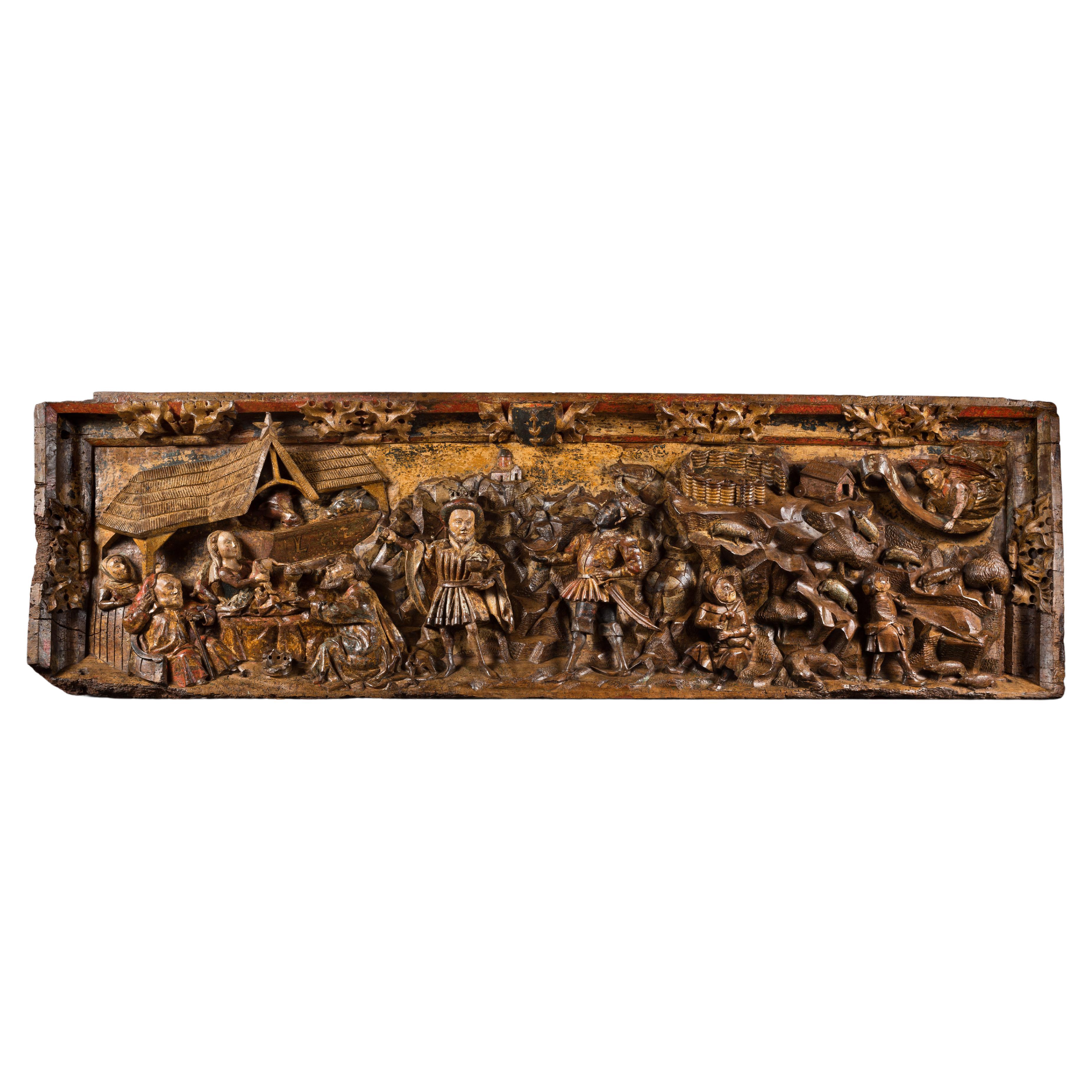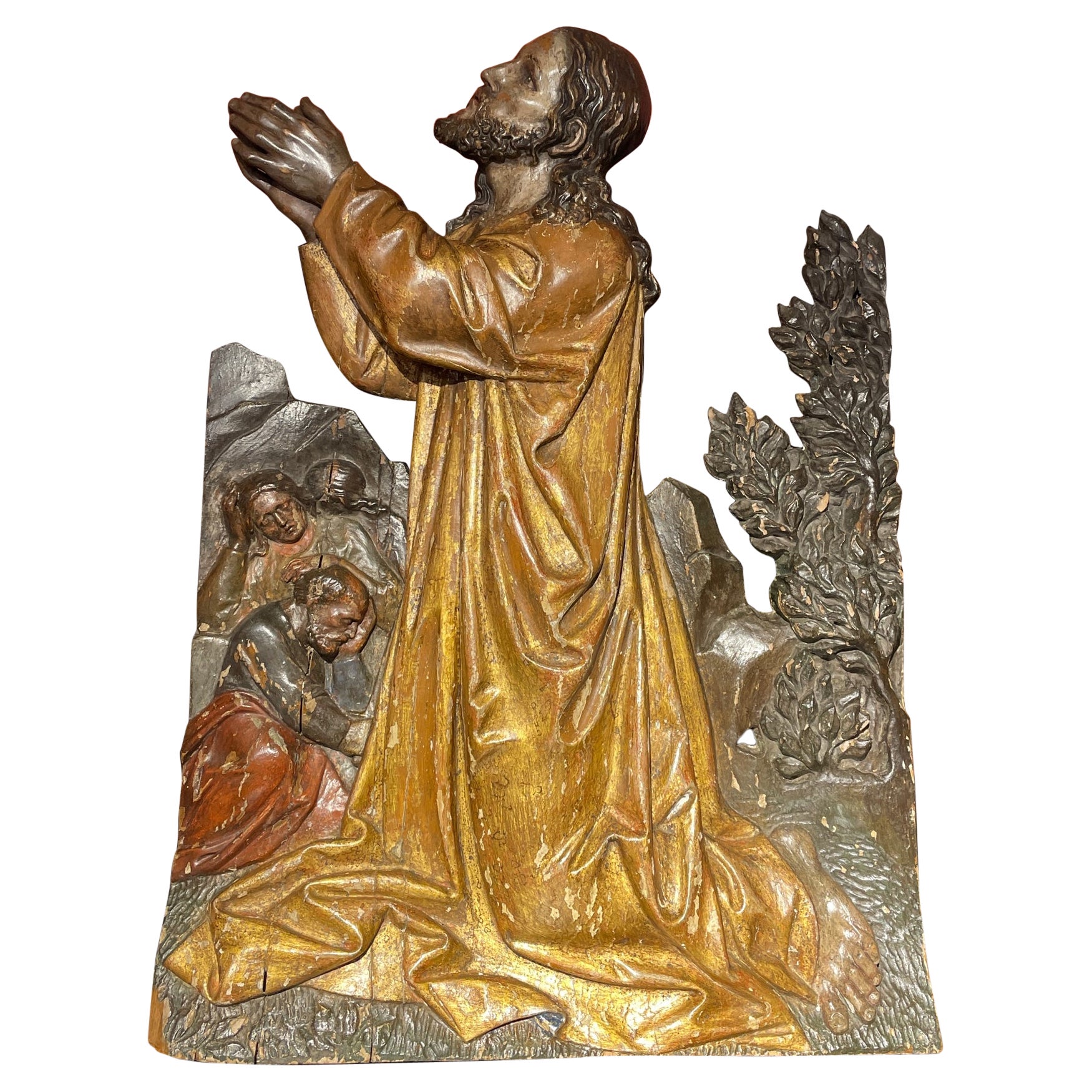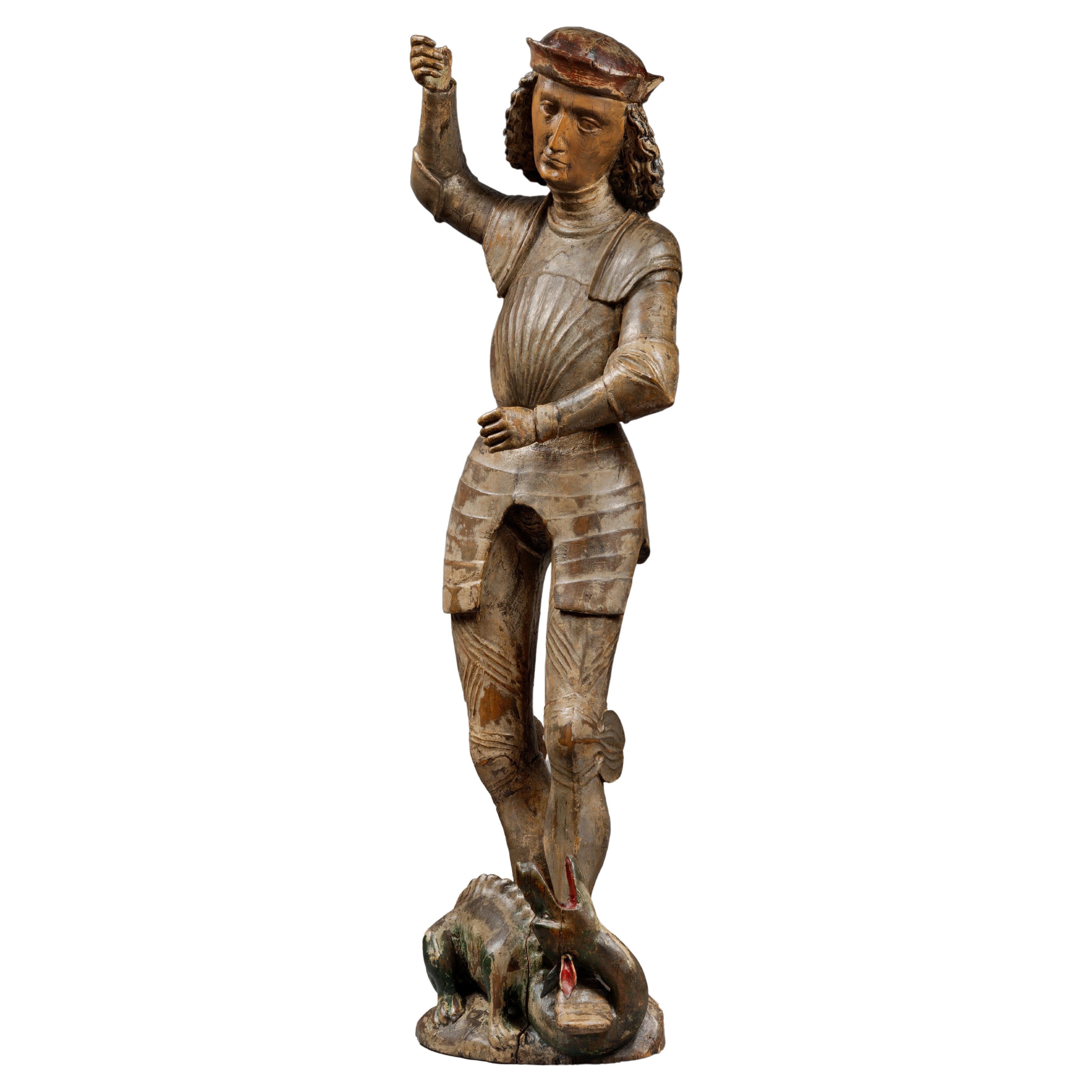Items Similar to Wood Low-Relief Depicting a Werewolf and Saint George
Want more images or videos?
Request additional images or videos from the seller
1 of 5
Wood Low-Relief Depicting a Werewolf and Saint George
About the Item
Exceptional polychrome wood low-relief depicting a werewolf and saint george after a woodcut by lucas cranach (“DER WERWOLF” 1512)
Provenance :
collection Brimo de Laroussihle
collection Mas.
This surprising low-relief, in a very fine condition, was made during the 16th century probably in Würtzburg in the Main Valley, Lower-Franconia where a characteristic school of sculpture flourished from the mid-15th century onwards.
The left-hand side of our low-relief depicts the legend of the werewolf.
In a farm’s courtyard, an unkempt man eats a child. Crawling like an animal, the man is shown turning into a voracious creature that catches and kills everything around him.
Several victim’s body parts are lying around him testifying of its regular attacks.
In the background, a mother raises her arms in despair while her two other children seek refuge by her sides. A man is watching the scene, safely sheltered in a stable.
Further in the back appears a large city.
The right-hand side of the panel represents the legend of Saint George.
The young Trébizonde, born a princess, lavishly dressed, is depicted in the bottom part of the low-relief, praying on her knees. She is kept in cavern by a dragon, of whom we can only see the head. The lady is the last victim the dragon has asked for. Indeed the lamb beside Trébizonde points her out as sacrifice.
On the tortuous path, Saint George is riding a white horse with the princess he freed from the monster. Trébizonde’s parents brings are awaiting for them from the top of a tower.
The crossbowman on the right evokes Saint George’s fight against the dragon.
This low-relief was made after to woodcuts by Lucas Cranach the Elder (1472-1553).
The first one is the famous “Der Werwolf” (162x126 mm), produced by the artist himself around 1512. One exemplar of this engraving is kept in the Cabinet des Estampes in Strasbourg (France). This woodcut has inspired the left-hand part of our low relief.
With no other equivalent in the work of Lucas Cranach the Elder and quite rare in the iconography of this period this peculiar picture might have found inspiration in one of Ovid’s Metamorphoses, the king Lycaon turned into a wolf by Jupiter (Cat n° IV 1). In medieval stories and sermons, such as Geyler de Kaisersberg’s, the werewolf is defined as a savage man, embodying animal’s primitive instincts and danger. As such he was closely related to the devil.
“Der Werwolf” had a mirror woodcut depicting Saint George killing the dragon. This image has inspired the right side of our low relief and sheds a new light on the panel’s symbolic meaning.
The panel is divided by leafless tree in two distinct parts, highlighting the antagonism between man and animal. The animal’s bestiality and foul instincts and on the other side the civilised man embodied by Saint George. He stands as the miles christianus that is the Christian knight.
Indeed Saint George was adopted as patron saint by the crusaders in the Holy Land after the siege of Antioch in 1097. From then on Saint George was considered a model of chivalrous virtues.
A social reading of these woodcuts and of this low-relief must also be done:
Cranach the Elder was Frederick III elector of Saxony’s court painter. While Saint George is the patron saint of the nobility he also acts as a model of virtue for the peasants. Plus on the background, the high perched castle gives a topographic and symbolic vision of the elector’s leading role.
Saint George was also the patron saint of archers and crossbowmen, armourers and feather workers (making the plumes of the knight’s helmets). We can see depictions of those artisans just above the princess.
From the 16th century onwards the worship of Saint George and its ideal of chivalry fades away with the increase of gun’s use and the loss of single combat’s practice.
In 1972, to celebrate the 500th birth anniversary of Lucas Cranach the Elder a travelling exhibition showcasing the most famous works of the artist was produced. This woodcut Der Werwolf -reminiscence of Albrecht Dürer’s Vision of Saint Eustace- was part of this exhibition which went through the following cities:
- Museum of Bielefeld (23.01 - 26.03.72)
- Kunstmuseum Düsseldorf (08.04 - 17.05.72)
- Wallraf-Richartz-Museum Köln (26.05 - 16.07.72)
- Kunstsammlungen der Veste Coburg (16.07 - 30.09.72)
Our low-relief was also exhibited during the exhibition El Salvaje Europeo at the Bancaja Foundation of Valencia and at the Contemporary Cultural Center of Barcelona in 2004. The picture appears in the catalogues, p.18-19 of “El Salvaje Europeo” (Valencia, Spanish language) and p.14 of “El Salvatge Europeu” (Barcelona, Catalan language).
The low-relief also featured in the story “Beaux objets sur le marché” from L’ Œil magazine dated December 1965 – N°132, p.48-49.
Literature
Hommeanimal. Histoires d’un face à face, cat. Exp. Strasbourg, musée archéologique, galerie Heitz, musée de l’œuvre Notre-Dame, Musée d’art moderne et contemporain, 7 avril 2004-4 juillet 2004, Musées de Strasbourg, Adam Biro, 2004.
Represented in Cranach in Coburg, Graphik von Lucas Cranach d. Ä., Lucas Cranach d. J. und der Werkstatt im Kupferstichkabinett der Kunstsammlungen der Veste Coburg, Stefanie KNÖLL, Meike LEYDE, Michael OVERDICK (Hg.), Editions Schnell Steiner, august 2020, page 313
- Dimensions:Height: 38.59 in (98 cm)Width: 37.8 in (96 cm)Depth: 3.94 in (10 cm)
- Style:Renaissance (Of the Period)
- Materials and Techniques:
- Place of Origin:
- Period:
- Date of Manufacture:16th Century
- Condition:Repaired. Wear consistent with age and use. Minor losses. Minor structural damages. Minor fading.
- Seller Location:Saint-Ouen, FR
- Reference Number:1stDibs: LU3115327271652
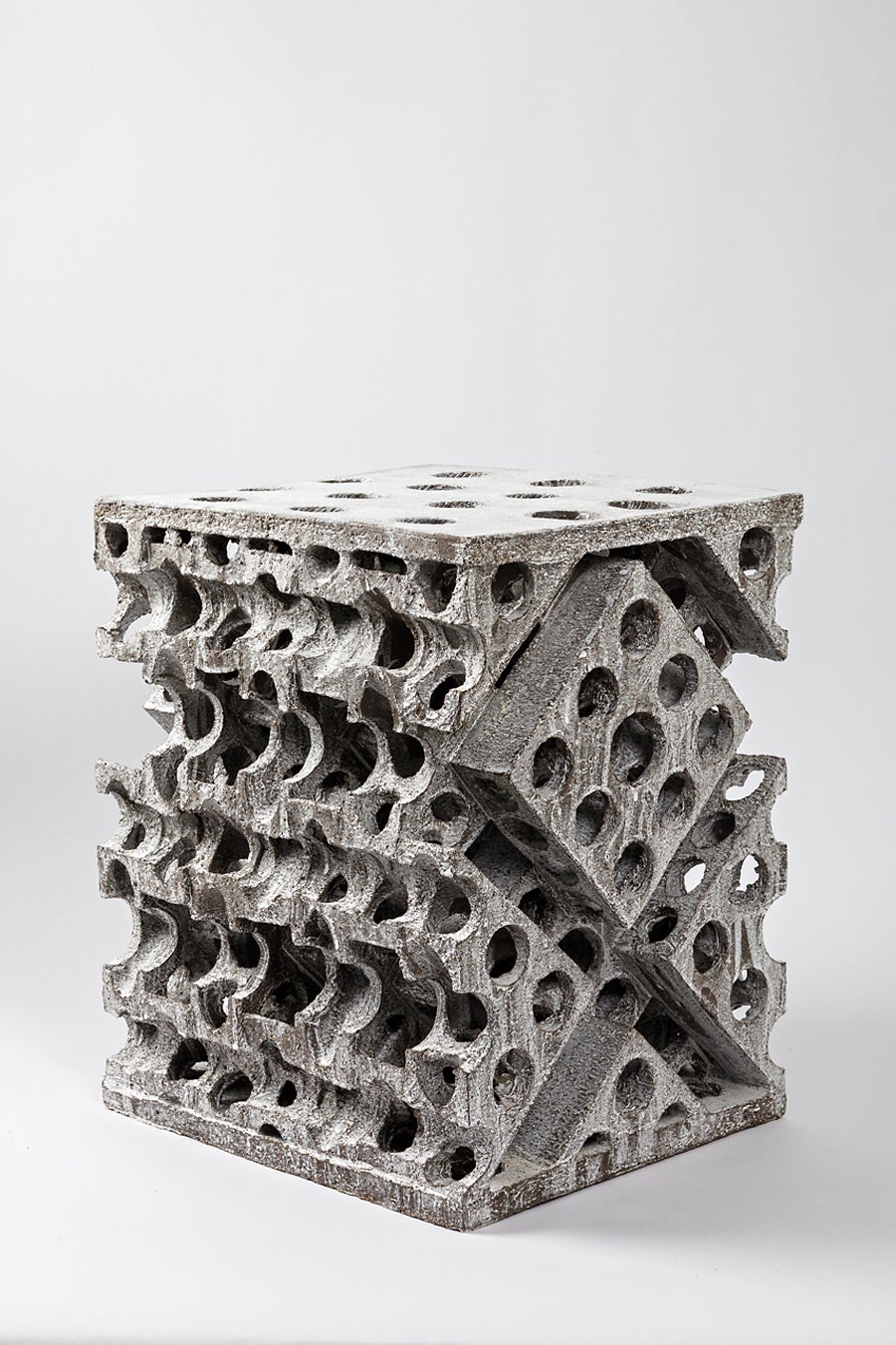
About the Seller
5.0
Vetted Seller
These experienced sellers undergo a comprehensive evaluation by our team of in-house experts.
Established in 2016
1stDibs seller since 2017
156 sales on 1stDibs
Typical response time: 8 hours
- ShippingRetrieving quote...Ships From: Saint-Ouen, France
- Return PolicyThis item cannot be returned.
More From This SellerView All
- Carved Wood Depicting Saint MartinLocated in Saint-Ouen, FRCarved wood depicting saint martin Origin : Germany Period : 15th century Measure: Height : 85 cm Wood Polychrome remains Good state of conservation Collection number on the back 26757 Our partially polychromed Saint...Category
Antique 15th Century and Earlier Figurative Sculptures
MaterialsWood
- 15th Century Burgundian Low-Relief Depicting Scenes of the NativityLocated in Saint-Ouen, FRProvenance : In the same private collection for several generations, Burgundy. The canonical Gospels describe briefly the episode of the Nativity. It comprises three parts : • The Preludes : the Journey to Bethlehem, the Census • The Nativity • The Announce to the Shepherds and the Adoration of the Magi Only the Gospel according to Matthew (2, 1-12) speaks about the Adoration of the Magi. Staying vague about their number it does say they brought the newborn gold, incense and myrrh. The apocryphals, the fathers of the Church and many other authors have filled in the gaps of the evangelic tale. The sobriety and symbolic of the story have been a huge inspiration to artists. Although one of the oldest depictions of the Adoration of the Magi dates from the 2nd century the theme became very popular in Christian art during the late 14th century. One of the reasons explaining this success is that it celebrates both the Virgin and Christ at the same time. This important walnut panel is carved in a strong relief and depicts the different steps of the story of Jesus’ birth. On the left, the donkey and ox that have accompanied Mary and Joseph from Bethlehem are depicted behind a trough. On the thatch roof appears the star that would guide the magi to the place of birth of Jesus. Mary is wearing a veil and is seating on a bed. She holds her baby at arm’s length to present him to the magi. Saint Joseph is by her side. The old man is holding a cane in his left hand while from the right hand he seems to uncover himself to greet the visitors. A woman assists to the scene. In front of the holy family the three magi stand behind one another to pay their homage to the newborn. The first magi has a pointed beard. He is already kneeling out of deference and has placed his crown to his feet. He gives the baby a hanap filled with gold coins. This is Melchior as the legend describes him with white hair and a long beard. Caspar, the second magi bears a cup of incense. He is looking at the third magi and with his right hand he points to the star that has guided them there. He has a short beard and wears crakow shoes, breeches and a wide sleeved doublet. Finally Balthazar, the elegant last magi proceeds proudly towards the holy family with his one hand on the saber’s hilt and the other holding a cup. He brings the divine child the myrrh. He probably just dismounted as the horse can be seen behind him. The scene is set in a very detailed and narrative decor. In the right part of the panel the shepherd receive the announce of Jesus’ birth. An angel comes down from heaven with a scroll bearing the good news in his hands. The herding dog sleeps peacefully while sheeps graze. At the top of the cliff we notice the gilded sheeps enclosure. The panel’s moulded frame is carved with a foliated decor. In it’s centre appears a coat-of-arms. It is the alliance of the three magi’s arms. Indeed as it was common for legendary figures the three of them received imaginaries coat-of-arms. Thus, on a field of azure stands a star for Melchior, a crescent for Caspar and a pennon for Balthazar. This high-relief panel is undeniably the work of a very skilled and imaginative artist. This key moment in the New Testament is transposed to a contemporary environment thanks to the figures’ clothing and the rural daily life scene. This way the universal dimension of the episode is highlighted allowing a better understanding for the contemporaries. The sculptor has represented the episodes of the Adoration of the Magi and the Announce to the Shepherd with great talent and numerous details giving life to a picturesque and narrative scene. The important traces of polychromy give those already very animated scenes a stronger pictorial power and a rich dynamism. Because of the picturesque and familiar realism so dear to the artists of the late Medieval era, of the didactic function of this type of panel as well as the quality of the sculpture this piece is an astounding example of Burgundian art of the 15th century. Literature Louis Réau, Iconographie de l’Art chrétien...Category
Antique 15th Century and Earlier French Gothic Figurative Sculptures
MaterialsWalnut
- Carved Polychrome Wood Depicting Saint FlorianLocated in Saint-Ouen, FRCARVED POLYCHROME WOOD DEPICTING SAINT FLORIAN ORIGIN : SWABIA, SOUTHERN GERMANY PERIOD : LATE 15th CENTURY Height : 98 cm Length : 29 cm Depth : 24 cm Polychrome limewood Very fi...Category
Antique 15th Century and Earlier Figurative Sculptures
MaterialsWood
- 15th Century Carved Wood Depicting Saint JamesLocated in Saint-Ouen, FRThe Saint depicted here is Saint James the Great. James is the brother of St. John the Evangelist. Nothing is known of his activities after the Ascension...Category
Antique 15th Century and Earlier French Gothic Figurative Sculptures
MaterialsOak
- Beautiful Sculpture Depicting Saint George Slaying the DragonLocated in Saint-Ouen, FRBEAUTIFUL SCULPTURE IN POLYCHROME LINDEN REPRESENTING SAINT GEORGE SLAYING THE DRAGON ORIGIN : SOUTHERN GERMANY, SWABIA PERIOD : LATE 15th CENTURY Polychrome linden wood, silvered flange Measures: Height : 104 cm Width : 21 cm Good state of conservation, original polychromy HISTORICAL Officer in the Roman army, Saint George passed through a city plagued by a voracious dragon that devoured its inhabitants. To appease the monster's hunger, the villagers offered him sheep, but when all the cattle were sacrificed, two young people were drawn. One day, fate designated the king's daughter, forced to be delivered to the dragon. Initiating a fight to save her, Saint George, on his horse, triumphed over the monster by piercing it with his spear. In order to symbolize the victory of faith over Evil, the different versions of the legend end with the death of the dragon. However, the Golden Legend, by Jacques de Voragine affirms that the creature was only wounded and that the saint would have dragged it, chained, at his side. Before leaving the city, Saint George distributed to the poor the money that the king had given him as a reward. After his victory over the dragon, came the passion of the saint. Indeed, Saint George was martyred for refusing to sacrifice to pagan idols during the persecution of Diocletian. The saint suffered numerous physical abuses from which he miraculously survived. He was eventually beheaded and his holy body was retrieved by an angel. DESCRIPTION This polychrome sculpture represents Saint George standing, his foot on the dragon which he strikes down with a spear. This image is one of the most evocative of the iconography of Saint George. He is represented young and beardless, in infantry armor, typically German, due to the length of the poacher who protects the thighs of the saint. The armor covers his whole body, from the neck, with the gorget, to the foot with the sabatons. The armor is realistic thanks to the precision of the parts composing it and this silver highlight which gives it a patina with metallic reflections The saint is wearing a hood with raised brown edges, revealing curly hair down to the bottom of his neck. The face of the saint seems serene, and his attitude controlled, a symbol of chivalrous virtues. Concerning the posture, Saint George raises his right arm and bends the left in order to plant his spear in the mouth of the dragon. He is in contrapposto, his left foot crushing the long neck of the monster. The dragon, on the other hand, is salamander-like with large, pointed ears and a large, jagged crest on its back. The creature opens its mouth and twists its neck in pain. A green color covers its skin, and highlights of red are located inside its mouth and ears. This exceptional piece is the reflection of a remarkable sculptural work, due to the harmony that emerges from the composition, the precision of the details and expressions, as well as the contribution of the polychromy that animates this scene. LITERATURE Louis Réau, Iconographie de l’Art Chrétien...Category
Antique 15th Century and Earlier Figurative Sculptures
MaterialsWood
- Important Polychrome Low-Relief Depicting Christ in the Mount of OlivesLocated in Saint-Ouen, FRIMPORTANT POLYCHROME LOW-RELIEF DEPICTING CHRIST IN THE MOUNT OF OLIVES ORIGIN: SOUTH GERMANY or ALSACE PERIOD: ca. 1500-1510 Height : 78 cm Length : 57 cm Depth : 8 cm Limewood ...Category
Antique 16th Century Figurative Sculptures
MaterialsWood
You May Also Like
- Cercle of Jacopo della Pila - Marble relief depicting a winged CherubLocated in Bruxelles, BECercle of Jacopo della Pila (Lombard, in Naples 1471-1502) Marble relief depicting a winged Cherub Naples, second half of15th century 40 x 57 x 12 cm Exquisitely carved, this relief portrays a winged cherub with cascading hair and delicate features. The cherub's plump, smooth countenance, rounded cheeks, outlined lips, and finely drawn nose emanate a sense of tenderness. The quadrangular module, is adorned with a carved frame. The relief ascends gradually, transitioning from the low relief of the wings to the high relief of the head. The rectangular frame and the subtly curved form of the artwork suggest that the relief likely adorned the upper part of an arch or a vaulted chapel. The type is that of the perspective room with a coffered ceiling decorated with figures of winged cherubs, which is found in various Neapolitan chapels of the 15th century. Coffered ceilings attest to the recovery of antiquity and the search for luxury in Renaissance architecture, first in Florence, then in Rome and Naples. The majority of the numerous family chapels and tombs built during the late fifteenth century in south of Italy employ the new formal vocabulary of the Florentine Renaissance in a self-confident manner that permitted a broad spectrum of variations. The escalating admiration for the classical world, coupled with the development of perspective, significantly contributed to the Renaissance endorsement of coffered ceilings. This artistic and constructive device drew inspiration from the intricate marble patterns observed in historical landmarks such as the Arch of Titus, the Temple of Vesta in Tivoli, the Pantheon, and the Basilica of Maxentius. A distilled product of both mathematical and artistic cultures, deeply scrutinizing the ancient world, the coffered ceiling plays a vital role in the perspective construction of space with its regular and directional geometry. The motif of the coffered ceiling decorated with cherubs in relief was introduced in Naples by Francesco Laurana in the plastic decoration of the Arch of Castelnuovo. Laurana's impact on the art scene in the south of Italy was profound. The introduction of the winged cherub into the region's artistic vocabulary bridged the gap between the classical and the contemporary, creating a synthesis that resonated with both aesthetic and spiritual sensibilities. His influence extended beyond the immediate visual appeal, shaping the cultural identity of the Renaissance in southern Italy. Although the plastic decoration of the Arch of Castelnuovo cannot certainly be ascribed to a mature Renaissance style, it was precisely on this occasion that the sculptors who worked there could get to know and export throughout the Italian peninsula that type of "Florentine classicism" which, even in the 15th century Naples, was conditioned by the Burgundian culture imported into the Kingdom by Alfonso of Aragon himself, with artists called from Spain and Northern Europe. The coffered ceiling, with its geometric patterns and Laurana's winged cherubs nestled within, became a symbol of refinement and cultural sophistication. The relief sculptures, carefully integrated into the overall design, transformed the ceiling into a celestial realm, inviting viewers to contemplate the divine while immersed in the grandeur of the Renaissance space. Similar winged cherubs appears also in the Naples cathedral. Within the renowned Succorpo Chapel, a mesmerizing marble coffered ceiling adorned with cherubs epitomizes the splendor of the Neapolitan Renaissance. The interplay of light and shadow on the textured surface of the marble coffered ceiling introduces an ethereal dimension, providing an immersive visual experience for observers. The geometric precision and the repeated patterns, reminiscent of classical motifs, establish a sense of harmony and balance that has become the hallmark of the Neapolitan interpretation of Florentine Renaissance aesthetics. Although probably intended to be admired from a distance, this cherub is intricately detailed and exquisitely rendered: the face and hair are elegantly outlined and the feathers are textured through juxtaposed lines. The marble, both figurative and decorative, adheres to the principles of balance and restrained ornamentation typical of the « Florentine Classicism ». Harmonious shapes and gracefully orchestrated curves , rooted in the classical repertoire, converge to evoke a sense of ethereal beauty. The surface displays the masterful use of a chisel to intricately carve the feathers and facial features, creating an almost abstract quality. This work is a testament to a sculptor of great skill and rich figurative knowledge, seamlessly blending classical firmness in contours with a refined treatment of the marble's surface. The combination of tradition and innovation point to a stylistic idiom from Lombardy, in particular we can find some comparaisons with the works of Jacopo della Pila, sculptor of Lombard origin working in Naples in the second half of the 15th century. He is documented there between 1471 and 1502, and is a protagonist of the Aragon Renaissance in the second half of the Quattrocento, together with the other great Northern sculptor active in the kingdom, Domenico Gagini. the first commission he received dates back to August 9, 1471, when Jacopo publicly committed to sculpting the funerary monument of Archbishop Nicola Piscicelli to be placed in the Cathedral of Salerno. The last known work is an altar ordered on July 29, 1502, by the noble Jacopo Rocco for the church of San Lorenzo Maggiore in Naples. Between these two chronological extremes (1471-1502), we must place the fervent activity of the artist, who had trained in Rome, perhaps under the guidance of Paolo Romano but also engaged in dialogue with other major artists of the city, especially Isaia da Pisa. He enriched his experience in Naples, initially drawing inspiration from the works of Domenico Gagini and later from the Tuscan masterpieces of Antonio Rossellino and Benedetto da Maiano destined for the church of Santa Maria di Monteoliveto. Jacopo della Pila's artistic personality is thus based on a complex interplay of influences, contributing to the definition of a highly personal style. Close comparaison can be made between our cherub and the winged angels reliefs...Category
Antique 15th Century and Earlier Italian Renaissance Figurative Sculptures
MaterialsMarble
- Six Decorative Panels, Carved Wood in Low ReliefLocated in Paris, FRSix decorative panels, carved wood in low relief. France circa 1980. Measures: Height: 36.6 in Width: 35 in Thickness: between 1.18 in to 2.8 in.Category
Vintage 1980s French Decorative Art
MaterialsWood
- Very Large Copper Wall Plate Depiction Saint Martin on Horse in ReliefLocated in Antwerp, BEA very large hamered copper wall plate depiction Saint Martin on horse in relief. Signed A Louis. Early 20th century. Measures: Diameter 75 cm.Category
Mid-20th Century European Baroque Decorative Art
MaterialsCopper
- Pair of Reliefs, Carved, Polychrome and Gilt Wood, Castilian School, 16th CLocated in Madrid, ESPair of reliefs. Carved, polychrome and gilt wood. Castilian school, 16th century. Pair of carved and polychrome wooden reliefs with figurative relig...Category
Antique 16th Century Spanish Renaissance Figurative Sculptures
MaterialsOther
- Medusa Low Relief by RomanelliBy Raffaello RomanelliLocated in Milan, ITAn extraordinary work of art by Romanelli sculptors, this low relief is inspired by the celebrated Medusa Rondanini, a Hellenistic marble copy of the ...Category
2010s Italian Sculptures and Carvings
MaterialsPlaster
- Virgin and Son with Saints Bas Relief 1960 ItalianLocated in palm beach, FLHand made bas relief from 1960 Italian, Mary holding baby Jesus accompanied by 6 Saints, made in resin on wood panel.Category
Vintage 1960s Italian Figurative Sculptures
MaterialsResin, Wood
Recently Viewed
View AllMore Ways To Browse
Antique Wood Works
Wood Saint
Carved Wood Relief
German Relief
Raised Relief
Wood Carved Decorative Panels
Low Relief
Antique Wood Saint
Wood Medieval
King George Furniture
16th Century German
Kills Germany
Mother And Child Wood
Antique White Lowes
Patron Saint
Mother A D Child
Antique Wood Room Divider
Knoll Barcelona
